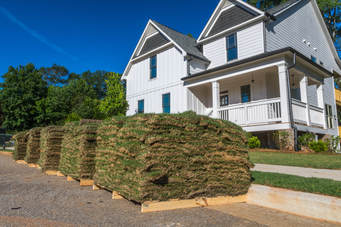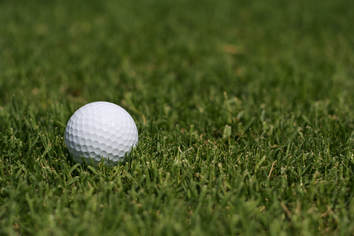Augusta, GA Lessons from the Lawn
Getting Down to Grass Tacks:
Know Your Lawn
Know Your Lawn
Spring time is coming just around the corner and the warmer weather is coming right along with it. We are about to start seeing grass come out of dormancy and start to green up, but there might be some of you out there who have never even thought about what kind of grass you actually have. It's important to know what species of grass your lawn is made out of because it will determine what kind of lawn care is needed. If you don't know, or even if you do, we here at Augusta Lawn Care and Maintenance might be able to teach you a thing or two.
So what exactly do I mean by “get to know your lawn”? You know that grass is green and that it needs water from time to time and probably some sunshine. Did you know, however, that some grass might not need as much sun as other grass types, or that some grass can actually die under a shady tree? Or what about how tall your grass needs to be? These are small examples of course, but it pays off to understand what makes your lawn different than your neighbors.
So what exactly do I mean by “get to know your lawn”? You know that grass is green and that it needs water from time to time and probably some sunshine. Did you know, however, that some grass might not need as much sun as other grass types, or that some grass can actually die under a shady tree? Or what about how tall your grass needs to be? These are small examples of course, but it pays off to understand what makes your lawn different than your neighbors.
In Augusta, we mainly find five different types of grass. These grass types are Bahia, Bermuda, Centipede, St. Augustine, and Zoysia. Around this time of year, you can also see Rye grass in some lawns. Rye grass especially loves the cold weather. So if you see a lawn full of nice green grass in January, you can bet it’s Rye grass. That or its full of winter time weeds. A lawn that is seeded with grass that grows during the winter, while giving you a nice green lawn year-round, will require more maintenance (and water) to keep it healthy, so be sure to consider this before going down to your local gardening department and buying a bag of seed to spread across your lawn.

Unless you live in a developed part of town, you will most likely have Bahiagrass growing in your yard. Bahia is easily recognizable by the long, thick stems that end in a “Y” shape that are studded with the black seeds. This type of grass is usually growing along roadsides and near rural areas because this is the more dominant, indigenous grass found in Augusta. Bahia is a relatively low maintenance grass that doesn’t require excessive watering to survive, but unless you want tall Bahia seed-heads brushing up against you everywhere you walk, you’ll want to consider mowing regularly. This particular type of grass likes to be mowed at about three inches tall; just long enough so it has long enough grass blades for gathering sunlight, but not so long that it becomes a nuisance. Bahia tends to grow in clumps so if you notice that your yard looks a bit patchy, then be sure to adopt regular mowing techniques to help this grass spread proactively.

Bermudagrass is the most common type of grass that you will see in developed neighborhoods. You can see pallets full of Bermuda grass lining the streets as new neighbors are developed. This is because Bermuda is able to take root well in the Georgia red clay that is everywhere if you dig down into the soil a couple of inches. This type of grass is also famously durable, able to withstand periods of drought and still grow. It can also withstand herbicide treatments cant well, but that's a talk for another day. You can tell if this type of grass is thirsty by looking at the grass blades. The blades will actually fold in on themselves and become little needles. If you see this phenomenon, or feel it if you happen to be barefoot, then be sure to water your lawn to relieve any stress that it might be experiencing.
A homeowner can actually “train” their Bermuda grass to develop its green color at lower heights by regular mowing. This is how golf courses usually maintain their fairways. Bermuda generally does well when keeping it to a height of two inches or so. If you have shady areas with lots of trees and tree roots, then you may want to consider using another kind of grass as Bermuda cannot tolerate shady areas. If you put down Bermuda sod in these areas, expect the grass to die off over a season or two. If you do have a more shady property, then you might want to look at our next grass type.
A homeowner can actually “train” their Bermuda grass to develop its green color at lower heights by regular mowing. This is how golf courses usually maintain their fairways. Bermuda generally does well when keeping it to a height of two inches or so. If you have shady areas with lots of trees and tree roots, then you may want to consider using another kind of grass as Bermuda cannot tolerate shady areas. If you put down Bermuda sod in these areas, expect the grass to die off over a season or two. If you do have a more shady property, then you might want to look at our next grass type.

St. Augustine is a grass that is capable of flourishing in shady areas. This is a type of grass where most of the plant exists on top of the soil with its roots planted in the dirt. Now I know you’re probably saying “Well isn't that true for most plants?” but most types of grass grow in little clumps, produce seeds, those seeds germinate in the soil, and then produce a new plant knit together by the roots of the older plant. With St. Augustinegrass, they have stolons, which are shoots that extend from the main plant to become another plant, that grow and move along the top of the soil and can be up to 3ft long in some cases. This allows St. Augustine to cover a significant amount of area if properly tended to. It also means that the grass is very susceptible to bugs, which feed on the nutrient filled stolons, and disease, because the stolons are not protected by the soil like other grass. St. Augustine is very quick to let you know if it is under stress because the leaf blades will show it very clearly by displaying grey and white spots on the leaf blades. This particular type of grass prefers to remain at a height of about three inches.

Centipede grass is very much like St. Augustine in how it grows but it is able to withstand both sun and shade. It has the potential to grow quite quickly in some areas, possibly even choking out other grass types that are present. Centipede is a very low maintenance grass. You can cut this grass type at higher intervals than you could in grasses like Bermuda. It also prefers to be mowed at about three inches. It does share many qualities with St. Augustine in that its stolons also grow on top of the soil which leaves it exposed to bugs and disease. A particularly cold winter can lead to wide spread grass loss as well. Adding a layer of top dressing can help Centipede grass survive the winter and this will actually give the grass some energy to grow in springtime. Centipede grass produces seeds as well which is one reason why it is able to spread so quickly.

The last of the common types of grass you see in Augusta is probably my personal favorite; Zoysia. This is a type of grass that is similar to Bermuda in that it grows in clumps rather than extending a far reach through stolons that grow on top of the soil. Zoysia grass is able to form a very dense clump of plants which allows it to seem very dense and this also allows it to keep weeds at bay. The density of the grass also allows it to feel extremely comfortable to bare feet. Regular mowing for this grass is generally all that’s need to keep most weeds out of the lawn. Keeping it mowed at two inches will allow this grass to maintain both color and strength. This grass is also great for seeding golf tee off spots because it allows the golf ball to sit on top of the grass blades without sinking to the bottom of the plant. Zoysia is also a very durable type of grass and sees very little issues with bugs or disease. All of these great qualities come at a cost though; a cost to your wallet, that is. It is the most expensive grass to purchase even though Zoysia does produce seeds, it is grows best when laid out in sod.
Every grass has its benefits and it’s down falls. You can ask our professionals at Augusta Lawn Care and Maintenance when they come out to service your lawn about any of the topics discussed here and how you can help your grass stay strong and healthy.
Until next time, friends!
- Your Local Lawn Professional
Until next time, friends!
- Your Local Lawn Professional

